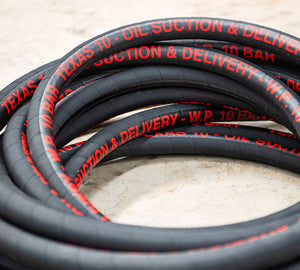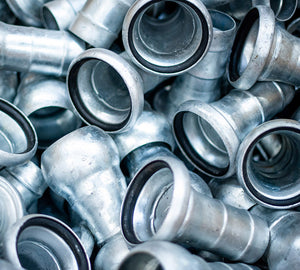Water Hoses
Industrial water hoses are heavy-duty hoses designed to transport water (and sometimes other fluids) in demanding environments like construction sites, factories, mines, agriculture and shipyards. They’re built to handle more stress, higher pressures and harsher conditions than the standard garden hose most people are familiar with.
Common Materials:
- Rubber: these hoses have excellent abrasion resistance, tend to be more flexible and have both hot and cold water applications.
- Reinforced PVC: a lightweight and affordable option but less durable in extreme conditions.
- Polyurethane: highly abrasion resistant and flexible.
Ideal applications:
- Construction and demolition: supplying water for dust suppression, cleaning and concrete mixing.
- Agriculture and irrigation: moving water from pumps to fields or tanks.
- Mining and quarries: handling large volumes of water and slurry in harsh, abrasive conditions
- Factories and plants: used in cooling systems, washdowns and water transfer.
Air Hoses
These are heavy-duty hoses designed to transport compressed air in manufacturing plants, construction sites, workshops and many other industrial environments. Unlike water hoses, they need to withstand not just physical wear but also high pressures, constant flexing, and exposure to oils or chemicals from air compression systems.
Common materials:
- Rubber: these are highly durable, flexible and resistant to the oils and chemicals from air compression systems.
- PVC: lightweight and affordable, but can be susceptible to stiffening in colder temperatures.
- Polyurethane: extremely flexible, lightweight and abrasion resistant, making it an ideal choice for coiled hoses.
Ideal applications:
- Construction and mining: powering pneumatic drills, hammers and jackhammers.
- Manufacturing and assembly: feeding compressed air tools like wrenches, grinders and nail guns.
- Automotive and workshops: air supply for painting, inflating, and air tools.
- General plant use: ventilation, cleaning and machinery operation.
Steam Hoses
These are a specialised type of hose designed to safely transfer steam, often at a high pressure and temperature. Because steam is much more dangerous than air or water if the hose fails, they are built with extra safety measures, heat resistance and durability in mind.
Common materials:
- EPDM rubber: excellent heat resistance to handle steam.
- Steel wire reinforcement: this provides extra strength to handle high pressure systems.
- Pin-pricked covers: these are tiny perforations seen in many options to let steam escape safely if the hose wall fails.
Applications:
- Chemical plants: cleaning, heating and process applications.
- Refineries and power plants: steam transfer for turbines and machinery.
- Food and beverage industry: steam cleaning of equipment and sterilisation.
- Shipyards and railroads: steam thawing, cleaning and heating tasks.
Materials Handling Hoses
These are designed to transfer abrasive bulk materials such as sand, cement, lime, powders, pellets, gravel or slurries and therefore need to be able to withstand extreme abrasion and wear caused by solid particles being moved at high velocity.
Common materials:
- Natural rubber: excellent abrasion resistance.
- SBR: a cost effective and durable option.
- Nitrile: resistant to oil and fuels if mixed with abrasive materials.
- Polyurethane linings: lightweight and extremely resistant to abrasion.
Applications:
- Cement and concrete: used to transfer dry cement or wet concrete.
- Mining and quarrying: transferring ores, tailings, gravel and slurries.
- Steel and foundries: handling sand and other bulk materials.
- Agriculture: transferring grain, feed and fertiliser.
Fire Hoses
Similar to water hoses, fire hoses are designed to deliver water (or other fire suppression agents) but do so at much higher pressure. While they are most familiar in firefighting, industrial versions are built to withstand harsh environments and chemical exposure.
Common materials:
- Rubber: often used in the inner tube to provide a smooth, water tight lining
- Woven polyester: used as a reinforcement layer for added strength.
- Outer jacket: fire hoses are rubber coated for resistance to abrasion, fire and chemicals.
Applications:
- Industrial fire protection: permanent hose reels and standpipes in plants, warehouses and oil/gas facilities.
- Shipyards and marine: fire suppression on vessels and docks.
- Mining and powerplants: quick response firefighting.
Chemical Hoses
These are specialised hoses designed to safely transfer aggressive or hazardous chemicals, solvents and corrosive fluids in industrial settings. Because chemical exposure can quickly degrade ordinary hoses, they are built with high chemical resistance, safety features and durability to protect both workers and other equipment.
Common materials:
- UHMWPE (Ultra-High-Molecular-Weight Polyethylene): high resistance to a broad range of chemicals while also being a lightweight and flexible option.
- PTFE (Teflon): extreme resistance to almost all chemicals and also capable of handling high temperatures.
- Viton: good option for oils, fuels and aggressive solvents.
- Rubber: ideal for acids and some alkalis.
Applications:
- Chemical plants and refineries: transferring acids, solvents and fuels.
- Pharmaceutical: handling solvents and cleaning agents.
- Agriculture: transferring pesticides, fertilisers and herbicides.
- Tank trucks and loading racks: bulk chemical transfer.
Composite Hoses
These are flexible, multi-layered hoses for transferring chemicals, fuels, solvents and other hazardous liquids safely. Unlike rubber hoses, they are constructed from multiple layers of thermoplastic films and fabrics which make them lighter, chemical resistant and more flexible while still strong enough for demanding applications.
Materials
- Inner Layers: Polypropylene, PTFE, or other thermoplastics depending on chemical compatibility.
- Reinforcement: multiple textile and film layers for strength.
- Wire Helices: stainless steel, galvanized steel, or polypropylene-coated steel which provide crush resistance and electrical conductivity.
- Outer Cover: abrasion-resistant fabric or PVC-coated fabric for weather and chemical protection.
Applications:
- Fuel industry: loading and unloading fuels, oils, and petrochemicals at docks, tank farms, and refineries.
- Chemical Plants: transferring aggressive acids, solvents, and alkalis.
- Marine and dockside: ship-to-shore transfer of bulk liquids.
- Transport (tank trucks and railcars): bulk chemical and fuel transfer.
- Hazardous materials handling: anywhere spill prevention and safety are critical.
Oil and Fuel Hoses
These are specialised flexible hoses designed for the safe transfer of petroleum based products such as gasoline, diesel, kerosene, crude oil, lubricating oils and sometimes biofuels. They are built to resist the hydrocarbons, oils and fuel vapors standard hoses cannot handle safely.
Common materials:
- Inner tube: nitrile, neoprene, or specialized synthetic rubber for hydrocarbon resistance.
- Reinforcement: textile braids, steel wire spirals, or both.
- Outer cover: oil, abrasion, ozone, and weather-resistant rubber (often CR, NBR, or SBR blends).
Applications:
- Fuel transfer: at fuel depots, refineries, and distribution terminals.
- Tank trucks and railcars: loading and unloading fuel products.
- Marine and dockside: ship-to-shore fuel transfer.
- Industrial plants: supplying fuel to machinery, boilers, and backup generators.
- Service stations: pump hoses for gasoline and diesel dispensers.
- Lubrication lines: moving oils in machinery maintenance.
Food and Drink Hoses
These need to be food-grade to transfer consumable products in the food and beverage industry. They need to comply with strict hygiene and safety regulations to prevent contamination and ensure they don't alter the taste, smell or quality of what they’re handling.
Common materials:
- EPDM rubber: great for hot water, milk, and beverages.
- Nitrile: suitable for fatty foods and oils.
- Natural rubber: flexible, abrasion-resistant, used for dry bulk foods (sugar, grains, flour).
- PVC and PU: lightweight options for general food transfer.
- Teflon: handles aggressive food additives, flavourings, and high temperatures.
Applications:
- Beverage industry: Breweries, wineries, and soft drink plants.
- Dairy industry: milk suction and discharge at farms and dairies.
- Food processing: transfer of oils, fats, syrups, chocolate, flavourings, and other ingredients.
- Dry bulk food transfer: flour, grains, sugar, and powders via pneumatic or mechanical systems.
PVC Hoses
PVC hoses are lightweight, flexible and cost effective options made primarily from polyvinyl chloride (PVC) and often reinforced with polyester yarn or rigid PVC spirals. They are widely used across industries due to their versatility, durability and resistance to many chemicals.
Applications:
Water transfer: irrigation, drainage, and general water supply.
Air supply: pneumatic tools, compressors, and workshop air lines.
Agriculture: fertilizers, pesticides, and irrigation.
Chemical industry: transfer of mild acids, alkalis, and solvents.
Food and beverage: clear PVC hoses for juices, milk, and potable water.
Construction: dust extraction, light slurry, and material transfer.
To explore a wide range of industrial hoses fit for any application, browse our range of high quality industrial hoses on offer.





